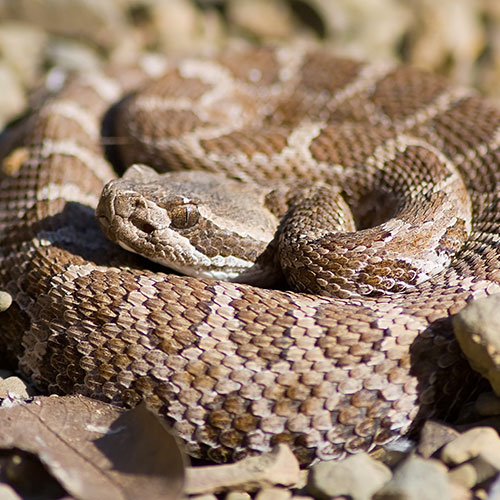FEATURED NEWS
How Timber Rattlesnakes Can Help Stop Lyme Disease
Written By Ryan Lessard (news@hippopress.com)
Images: Stock Photo
New Hampshire’s timber rattlesnakes are endangered, but that’s not a good thing, biologists say. Despite the venomous snakes’ stigma, they’re more likely to help people than harm them, by interfering with the process through which Lyme disease is spread.
Why They’re Endangered
Here in the northern edge of the much-maligned timber rattlesnake’s range, the creature is slow and docile and spends eight months of the year hibernating, according to New Hampshire Fish and Game biologist Mike Marchand.
“Most of the rattlesnake bites involve either people intentionally trying to kill them or really messing with them,” Marchand said.
But they are venomous. So for hundreds of years the Crotalus horridus has been unwelcome in the domain of man. Marchand said snakes are generally already one of America’s’ top fears, but rattlesnakes are even scarier to most people.
Marchand was hesitant to downplay the dangers of a timber rattlesnake bite, but he did say modern medicine can generally prevent death given the chance to intervene in time.

“There’s thousands of snake bites in the United States every year of all venomous species and typically, less than five end up being fatalities, and those don’t generally involve timber rattlesnakes,” Marchand said.
Still, Marchand said, people have historically targeted the rattlesnakes for persecution.They were easy to kill because timber rattlesnakes gather to hibernate collectively at particular den sites. In the past, humans have been known to target those sites and smoke the snakes out or stab them individually while they rest.
“Rattlesnakes have been declining for a long time in the Northeast and especially in New England,” Marchand said.
After years of persecution and development around their habitat, there is now only one known population of timber rattlesnakes left in the state. Its location is a closely kept secret to protect the animals from further persecution, though Marchand says it’s south of the White Mountains.
Timber rattlesnakes were extirpated from Maine and Rhode Island; there are a few populations in Massachusetts, and Vermont has two populations, Marchand said.
But these snakes already have a hard time making a living without humans getting in the way. Marchand said they don’t begin reproducing until the females are between 6 and 8 years old, and then they only reproduce about every three years because of the time it takes to recover.
“If you have a population of 30 animals then you may only have two or three or four females who are giving birth, or zero, within a given year,” Marchand said.
They’re so slow moving that crossing a busy road is almost certain to be fatal, and since the state only has one population left, it’s more vulnerable to diseases due to a lack of genetic variability.
A study in the early 2000s found that heavy rainfall during a critical time usually used by the snakes to bask and recover body heat after hibernating caused a condition called snake fungal disease. Those snakes who couldn’t shed their fungal lesions before re-entering hibernation didn’t survive.
Why We Want Them Around
Marchand said snakes are useful at eating all manner of garden pests and small rodents and don’t carry diseases themselves. But a critical way these snakes can help humans is by eating one of the key species in the blacklegged tick lifecycle — white-footed mice.
“That’s been a pretty popular selling point that I’ve seen thrown out there in the last six months or so,” Marchand said.
A recent university study found that timber rattlesnakes released on a population of white-footed mice resulted in the elimination of 2,500 to 4,500 ticks.
Ticks feed on the mice during their nymphal stage and the mice are known to carry the bacterium that causes Lyme disease and other pathogens harmful to humans.
Marchand said other animals are helpful at eating mice too, but the more snakes we have, the better.
“Rattlesnakes are part of that puzzle picture. They’re also helping to keep those rodent numbers down,” Marchand said.
